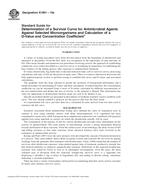Potrebujeme váš súhlas na využitie jednotlivých dát, aby sa vám okrem iného mohli ukazovať informácie týkajúce sa vašich záujmov. Súhlas udelíte kliknutím na tlačidlo „OK“.
ASTM E1891-10a
Standard Guide for Determination of a Survival Curve for Antimicrobial Agents Against Selected Microorganisms and Calculation of a D-Value and Concentration Coefficient (Includes all amendments And changes 11/5/2015).
Automaticky preložený názov:
Štandardné Príručka pre stanovenie prežitia krivky pre antimikrobiálnych látok proti vybraným mikroorganizmov a výpočet D-hodnoty a koncentrácie Koeficient
NORMA vydaná dňa 1.10.2010
Informácie o norme:
Označenie normy: ASTM E1891-10a
Poznámka: NEPLATNÁ
Dátum vydania normy: 1.10.2010
Kód tovaru: NS-43469
Počet strán: 5
Približná hmotnosť: 15 g (0.03 libier)
Krajina: Americká technická norma
Kategória: Technické normy ASTM
Anotácia textu normy ASTM E1891-10a :
Keywords:
concentration coefficient, concentration exponent, D-value, death rate curve, decimal reduction time, fraction-negative (FN), log death time, most probable number (MPN), survivor curve, Antimicrobial formulations/testing, Concentration (of elements), Death rate curve, Decimal reduction time, Disinfectants/disinfection, Fraction negative (FN), Log death time, Microorganisms, Most probable number (MPN), Survival curve, ICS Number Code 11.080.20 (Disinfectants and antiseptics)
Doplňujúce informácie
| Significance and Use |
|
The different procedures and methods are designed to be used to produce survival data after microorganisms are exposed to antimicrobial agents in order to calculate values that can be used to analyze and rationalize the effectiveness of antimicrobial agents when tested using other, often applied test methods. The data from these test procedures may be used in the selection and design of other tests of effectiveness of antimicrobial agents, some of which may be required by regulatory agencies to establish specific claims. Basic kinetic information about killing rate often serves as the initial information on which a testing program can be built. |
| 1. Scope |
|
1.1 This guide covers the methods for determining the death rate kinetics expressed as D-values. These values can be derived from the construction of a kill curve (or survivor curve) or by using other procedures for determining the number of survivors after exposure to antimicrobial chemicals or formulations. Options for calculations will be presented as well as the method for calculation of a concentration coefficient. 1.1.1 The test methods are designed to evaluate antimicrobial agents in formulations to define a survivor curve and to subsequently calculate a D-value. The tests are designed to produce data and calculate values that provide basic information of the rate-of-kill of antimicrobial formulations tested against single, selected microorganisms. In addition, calculated D-values from survivor curves from exposure at different dilutions of antimicrobial can be used to show the effect of dilution by calculation of the concentration exponent, η (2). 1.1.2 As an example of potential use of kill curve data, the published FDA, OTC Tentative Final Monograph for Health-Care Antiseptic Drug Products, Proposed Rule, June 17, 1994 has suggested the testing of topically applied antimicrobial products using survival curve (or kill curve) calculations. The methods described in this guide are applicable to these products, but adjustments such as the use of antifoaming agents when the reaction mixture is stirred may be necessary to counteract the presence of detergents in many formulations. Frequently the sampling for these tests is done after very short intervals of exposure to the formulation, such as 30 and 60 s. This methodology also has been applied to preservative testing of antimicrobial ingredients in more complex cosmetic formulations (5). 1.2 The test methods discussed should be performed only by those trained in microbiological techniques. 1.3 The values stated in SI units are to be regarded as standard. No other units of measurement are included in this standard. 1.4 This standard does not purport to address all of the safety concerns, if any, associated with its use. It is the responsibility of the user of this standard to establish appropriate safety and health practices and determine the applicability of regulatory limitations prior to use. |




 Cookies
Cookies
